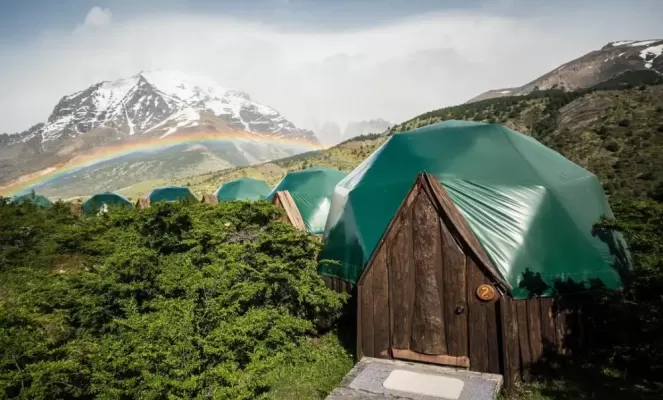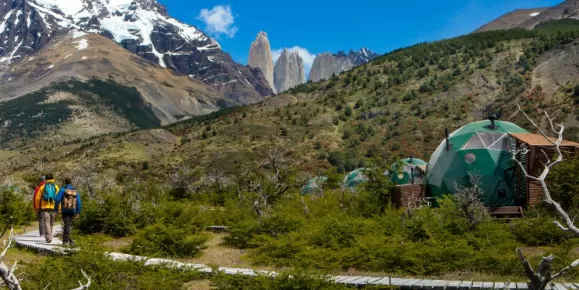In this world of vanishing wilderness, EcoCamp invites you to explore remote Patagonia with the least ecological impact possible; to trek in virgin beech forests; to admire colossal calving glaciers; to think and wonder about humankind while standing at the foot of the towering granite peaks of the Torres del Paine; to sit in total silence under the Southern Cross, and to share a glass of wine with new friends on your Patagonia tour.
About EcoCamp
The basic premise of designing the EcoCamp was to maintain the nomadic spirit of the ancient inhabitants that moved along the dismembered coast looking for food and shelter. These people lived in harmony with Mother Nature and built their huts out of wood, furs and leathers, all organic materials they found on site.
In Patagonia, from Golfo de Penas to the Strait of Magellan, these natives were called Kawesqar or Alacalufes, sadly nowadays the few remaining pureblood Alacalufes are no more than 10 and live in the remote village of Puerto Eden.
Kawesqar people built their huts on a geodesic shape bending branches and covering the structure with guanaco and sea lion skins. When whale hunters and marines established bases on their domains they abandoned their traditional ways of shelter and adopted new materials
and construction patterns.
Patagonia EcoCamp design was inspired by the traditional Kawesqar hut resembling an igloo and a dome at the same time. The instinctive engineering ability of the Kawesqar can be easily understood these days. The semi-hemispherical structure of the EcoCamp domes is formed by a number of isosceles triangles that provide uniform distribution of the stress caused by severe wind loads. Wind speed in Patagonia often surpasses 160-180km per hour which makes traditional straight and flat walls extremely vulnerable if the structure is meant to be light. Another significant aspect is that rounded bodies minimize the external surface in contact with the cold environment allowing less exchange of temperature with the warm interiors. Finally, semi-hemisphere gave Kawesqars the maximum internal space in relation to the surface they had to cover with valuable and sometimes scarce animal skins.
Patagonia EcoCamp is a tribute to Kawesqar dwellings and way of life.
Staying at EcoCamp
Comfortable as your home, wild as Patagonia...
Get 100% true eco-lodging, no faux green promises, and
Services beyond your sweetest outdoors dreams!
Patterns for Designing
The main concepts kept in mind when designing the EcoCamp were the following:
- To be exposed to nature as in a camp tent but with the comfort and sophistication of a four-star hotel;
- Design and build interfering as little as possible with the environment. The hotel is not meant to be seen. No one is interested in advertising EcoCamp on site
- Take advantage of the sight. EcoCamp gives sight to the Torres del Paine granite pillars right from the dining room and from many dormitory domes
- The nomadic spirit should be brought alive, let's make the hotel portable, so when moved, very little tracks of previous existence on site will be left;
- EcoCamp allows the terrain to recover after each season, let the grass grow, the animals graze, the sun shines and the wind blows all over the place. The domes are removed each winter.
- The wind is an active part of Patagonia, and it is important that guests experience it, so the canvas that covers the domes will react to the wind. You will be perfectly comfortable on the bed but aware that nature is outside knocking at the door;
- The skies in Patagonia can be spectacular at night, and the domes let guests fall asleep looking at the stars above
- Days in Patagonia are long from 5:30AM to 11PM and the best light for photographs is at dusk and dawn. The domes let the light flood the interior warning you that day is on. Grab your camera and get out to catch the first lights striking the mountains;
- Travelers come this far to be outdoors, let's make the indoor amenities as little as possible;
- The maximum capacity will be 30 guests so the feeling of intimacy, the idea of being in a Nomadic convoy will be kept even if the EcoCamp is full.
Construction and Energy Supply
EcoCamp has been constructed with intentional goals and objectives. Here are some examples of how EcoCamp has been designed with sustainability in mind:
- Construct with what you have onsite and minimize the importation of materials that do not exist in the place.
- Minimize the constructed area and leave indoors only the necessary places such as dormitories, living room, dining room, kitchen and bathrooms.
- Geodesic domes, reminiscent of the Kawesqar hut, will be the basic building module. Animal skin coating should be replaced by sturdy clothing.
- Avoid foundations. Terrain should be impacted as little as possible.
Energy Supply
In finding the proper sources of energies environmental design consider using the natural forces that are found on-site and that humanity has learned to use for its benefit. EcoCamp obtains all the energy from 100% natural & renewable sources like water, sun, and wind.
- Solar energy has been widely used in Patagonia especially during our summer season when the days can have 17hrs of daylight. EcoCamp uses solar panels to provide energy for small fans on the toilettes chutes and to light the circulation areas.
- Wind energy is still on an experimental stage in Patagonia, the lodge's experience with two generators has been diverse and the main difficulties reside in that the wind flows very irregularly with strong currents at certain hours and not a breeze in others. Nevertheless, they have been able to provide lighting for dormitories out of the wind generators.
- EcoCamp uses propane for heating water in the bathrooms and for the kitchen stove.
- Despite some investigators claim that the toxic emissions from a modern wood heater are similar to emissions from burning fossil fuels EcoCamp is considering the feasibility of using modern wood calderas to provide some sort of central heating and eventually modern wood stoves for cooking. In the vast plains of Patagonia, there is plenty of fallen dead wood that could be collected. Trees absorb carbon dioxide from the atmosphere, and by photosynthesis, release oxygen and store carbon in the wood. When wood is burned, the carbon dioxide is re-created and released into the atmosphere. This is the same amount of carbon dioxide that would be released should the tree die and rot on the forest floor. This is known as the "carbon cycle" and is environmentally neutral. The contra is that wood heaters generate four times the particulate emissions than oil combustion and ten or more times the particulate emissions than natural gas, though Particulate Pollution will never become a problem in windy Patagonia it is a matter of consideration.
Putting in practice the considerations described above results on the fact that we can provide our guests with very limited and discretional electrical power: No hairdryers, no battery recharge, no electrical shaving machines, no long showers, no internet, etc.
Passive heating & lighting:
The best way to preserve is with no doubt not to heat nor to light at all and keep up with the natural rhythm. Domes have a panoramic window and come coated with white canvas which allows plenty of sunlight inside. Coating considers an outer canvas layer and a thick insulation cushion to minimize the exchange of temperature.
Location
Patagonia is home to a world heritage site Torres del Paine. This National Park has unlimited beauty and adventure to offer, with glaciers, lakes, mountains, wildflowers and birds, trekking and horseback riding to choose from. Outdoor recreation at its best, our trips in Patagonia offer accommodation in camping or Refugio or top-class hotel. Suitable for group, individual or family vacations.
Operated by
Ecocamp Patagonia

















/663x400.webp)

























